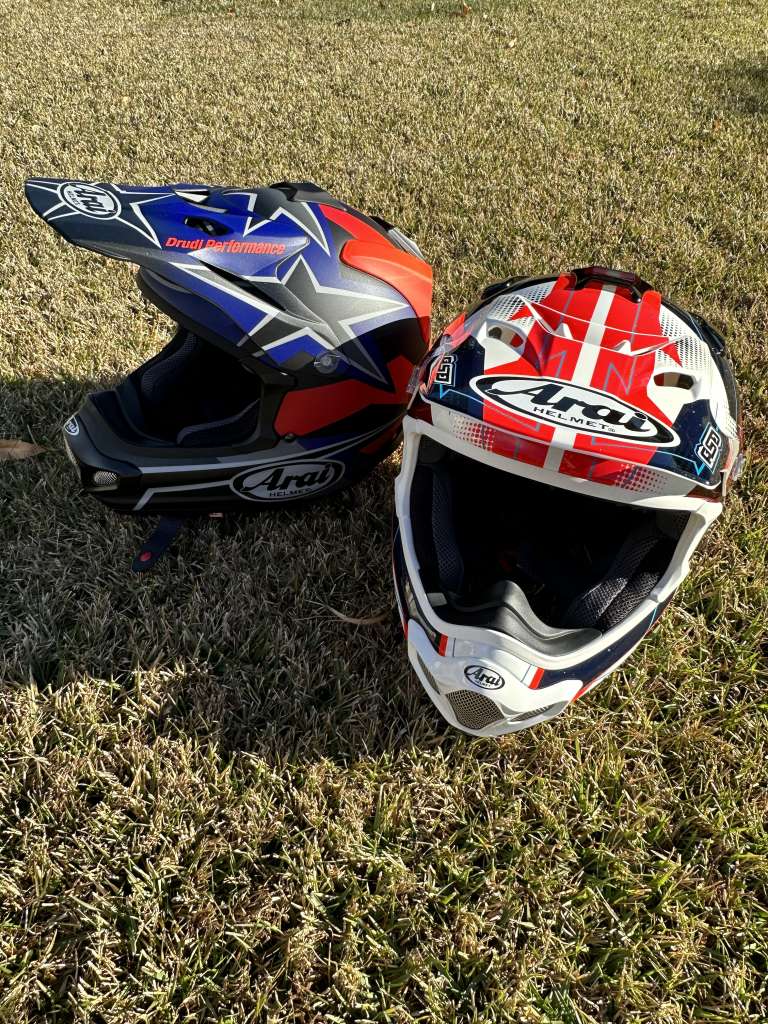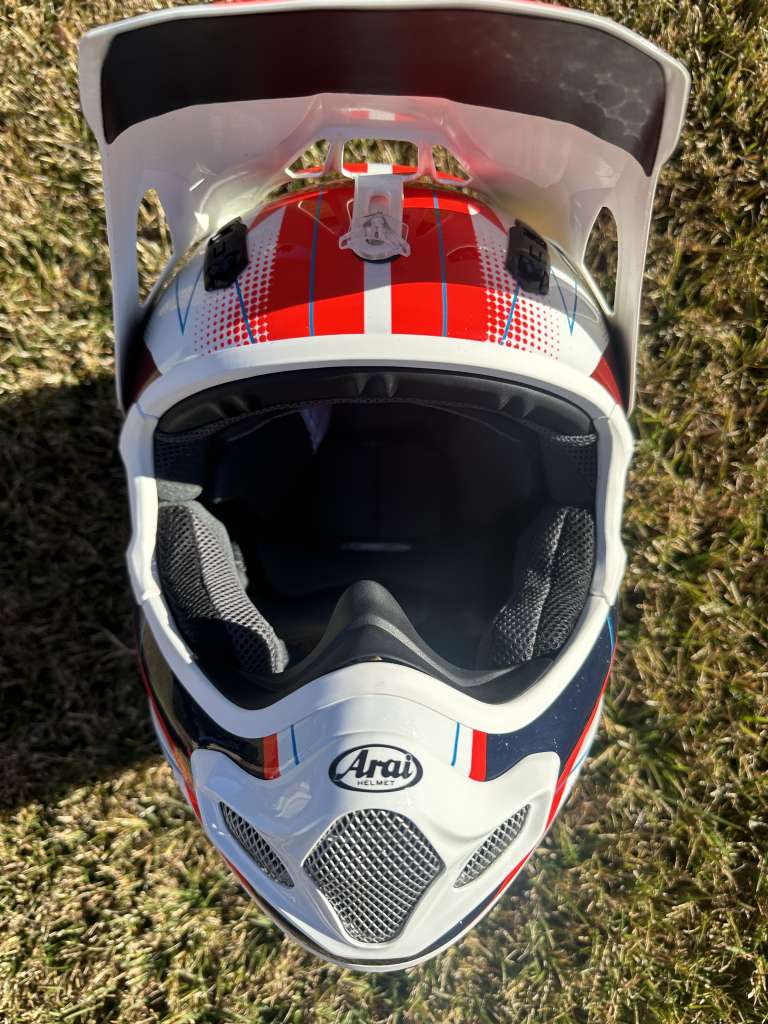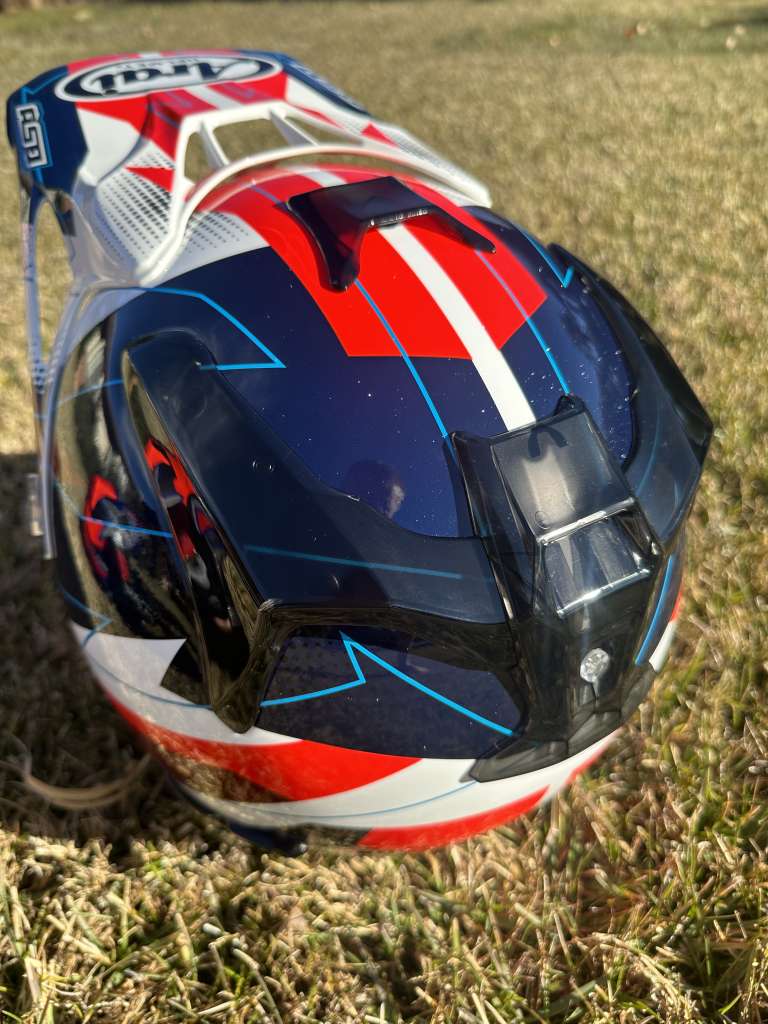Share This Article
I haven’t tested or worn another helmet in a couple years so I thought I would start revisiting some helmets in order to give you an “up to date” accurate review or slight comparison. Most of the time when I race, I am in a 6D ATR-2 helmet, but that doesn’t mean there are not other options that are good out there. I spent a block of time in Europe recently and took a couple different lids with me to break down some key aspects (besides the crashing) of each helmet. Now before we move on to the Arai VX-Pro 4 talk, I do believe in the 6D ATR1/2 as well as the Fly Formula tech and even though Arai hasn’t updated their helmet in quite some time, it is still one of the BIG 5 that are worth putting on your head (to me). Here are some thoughts after I have racked some hours and a slight spill on the Arai VX-Pro 4.

The VX-Pro 4 shell itself is consistently round and smooth, maintaining the R75 shape concept. Here, the rounded chin bar maintains the same compact shell length as the previous older model, the VX-Pro3. The result is less protrusion, which is said to be less likely to catch and dig in during a spill. In order to maximize performance, Arai precisely assembles the shell from multiple proprietary components. Super Fiber, one of the primary materials, can cost up to six times more than standard fiberglass yet can provide 30% higher tensile strength and increased penetration resistance. The cLc (complex Laminate construction) method demands precise and time-consuming assembly by master Arai craftsmen from many individual pieces. Installed on the uniquely rounded chin bar, the stainless mesh grill is mounted from the outside on the exterior vent cap and can be easily removed for cleaning or damage replacement, which I tried a couple times. The vent cap is also designed to break away from the chin bar in the event of impact. The Air-Through top-rear-duct center brace also functions as a goggle-strap locator. The diffusers can be removed or replaced quickly and easily by removing a single screw on the rear-duct center brace. Maybe not a huge deal, but no one wants to look like a goon so the “Goggle-Strap Locator” keeps the goggle strap in position even during aggressive, or Barcia like competitive riding. The new top-rear-duct center brace, together with the side port cowlings, also assist in keeping the strap in position on the side and back areas.
Starting with the basics of the Arai VX-Pro 4 lid, the visor is long and wide enough to provide better protection from other riders roost. What was odd to me was that the visor comes with a black sticker on the underside to reduce glare (maybe for off-road guys?) and has large air vents for an ample amount of ventilation. Rather than Arai drilling more or larger holes in the shell, the venting pieces on the top and back of the helmet have been designed to be more efficient at moving air through the helmet. On the much older Arai’s I had a problem with the front of the helmet being too close to my big nose, but all current Arai VX-Pro 4s has since moved the grill and mouth vents to the front of the bar, creating more space in front of my face. The cheek pad design hinges out of the way when taking on or off the helmet, yet is supportive and secure while riding. As with all Arai helmets, the Pro 4 features a multi-density foam that Arai claims, in conjunction with the helmet’s stiff shell, provides better protection in a wide variety of crashes.

When I first slipped on the medium sized helmet, I noticed how much material was making contact with my face/head. The cheek pads are long (towards the front of my mouth) and tall and extend well past the bottom edge of the shell which I really like. Combined with the padding around the rear of the helmet, the VX-Pro4 has a very “round head”’ feel, unlike other helmets that can feel more on top of the head. I have a round shaped head so this type of shell makes it one of the most comfortable lids to wear on longer test days. The pillow like feel of the liner is one of my favorites and if there is a standard for comfort on long riding days, the Arai VX-Pro4 helmets are close to the best for me. The ERS (Emergency Release System) cheek pads have a snug feel to it and wraps around my cheeks with a snugger fit, but if you do have a fat face then Arai offers optional customizable cheek pads to snap in. This is a great option for you guys that don’t like cheek pads touching/pushing on your cheeks as much. I do know that the sizing is slightly on the small side of the spectrum. I am normally a size medium and although the medium fits, it is much snugger than other helmets like the 6D ATR-2, Shoei VFX-W and Fly Formula. Going to an optional thinner 25mm cheek pad can really dial your fit in better if you’re on the snug side. At $749.95 this is one of the higher priced helmets, but the comfort you get from the Arai is well worth the price marker.

Ventilation is not the VX-Pro4’s strong point compared to some other models like the Fly Formula or even a Bell Moto 10. Like I mentioned earlier, it’s “ok” but on hotter days in the desert, I was sweating more with the Arai than others. Arai’s primary goal of having the strongest shell makes for very few vent holes. The lack of ventilation is pronounced by the amount of the very comfortable/plush foam lining. The relief zones for your ears are pretty small and I felt more material in that area than with other helmets (hence the comfort). This makes the Arai a very quiet helmet inside while riding compared to a louder 6D, but the 6D ventilates slightly better for me. The Fly Formula is the standard for ventilation at this point in the motocross helmet game and Arai has some work to do to get to that point. The goggle port is on the small side and to accommodate larger goggles (like my favorite pair of Oakley Airbrake’s) or goggles with nose guards, it’s tough to get them situated inside the port creating a good seal. I removed the rubber nose protector immediately on the VX-Pro4 to get extra room for goggles. This didn’t really hinder roost protection as I still incorporate the nose guard that is attached to the goggles. Just have some patience for fitment but most current goggles will seal well within the Arai eyeport.
Don’t be scared to throw the liner in the washing machine as the liner can withstand the abuse of the washer just don’t throw it in the dryer. Let the liner air dry and you will be just fine. With the VX-Pro4, there is a balancing act with safety and comfort. After watching a bigger man stand on the empty shell of a Pro4 without it flexing much at all, I got a good taste of how strong and hard this shell is (similar to a SHOEI VFX-W). Maybe this is some of the older tech that is being used by Arai, compared to the newer tech that 6D, Fly or Bell have been putting out. Plus, with Arai’s triple density foam and breakaway visor and vent pieces, I have little doubt that the helmet would perform very well in a high speed crash. However, since it isn’t the lightest or most ventilated helmet on the market, you have to decide for yourself where you fall in the wide spectrum of helmet comfort and performance. I personally love the comfort so it’s one of my top three helmets to ride with, but with further advancements in helmet tech as of late, Arai may need to latch onto some newer safety features soon. Also, not to be lost is the fact that Arai has some damn nice color ways available so it might be worth the time to check their website out or your local dealer.
You can check them out at araiamericas.com and see all the designs they have available. If you have any questions feel free to email me at kris@keeferinctesting.com
